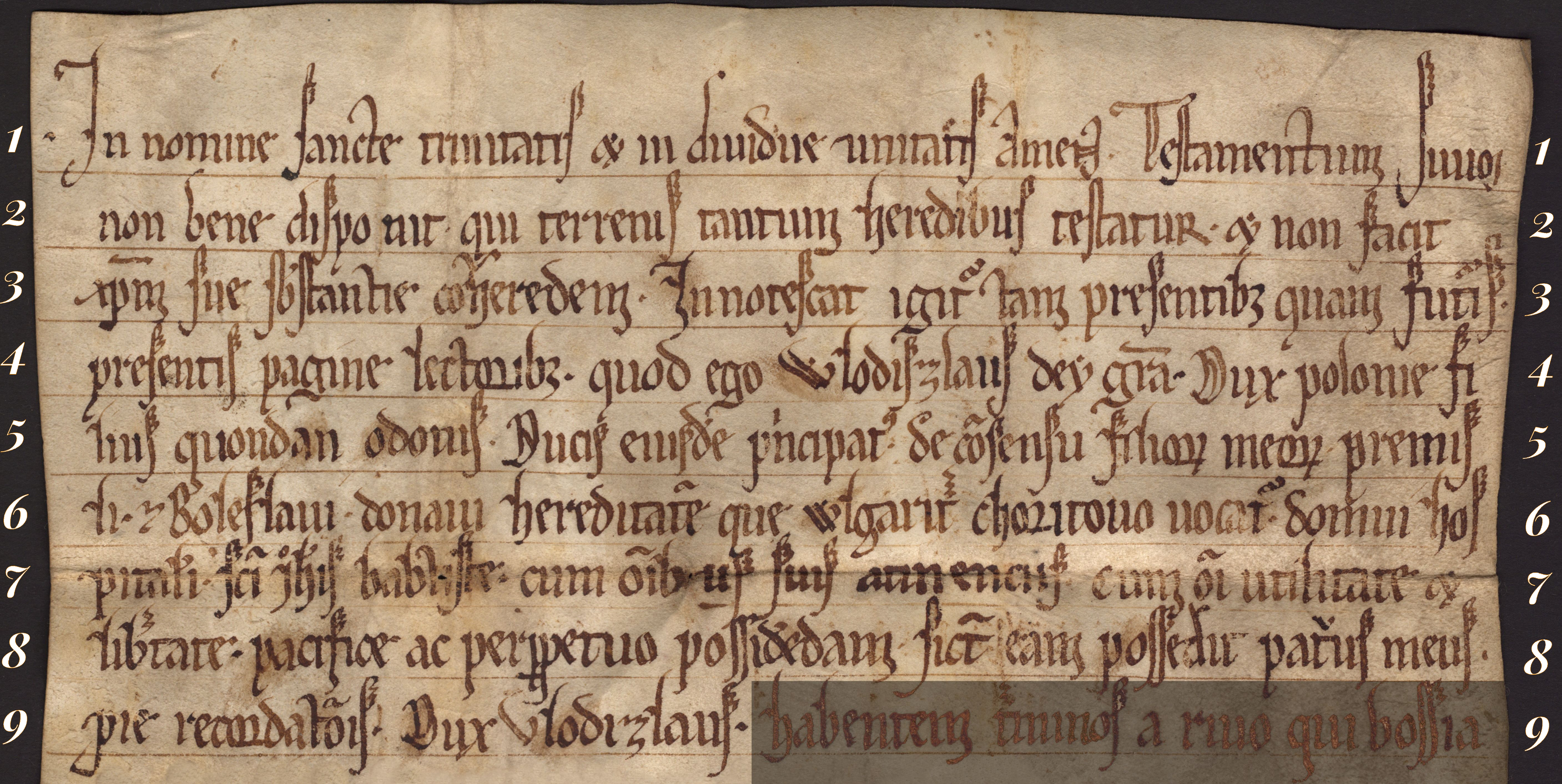Exercise 2

1. In nomine Sancte trinitatis et in dividue unitatis Amen Testamentum suum
2. non bene disponit qui terrenis tantum heredibus testatur et non facit
3. Christum sue substantie conheredem Innotescat igitur tam presentibus quam futuris
4. presentis pagine lectoribus quod ego Wlodiszlaus deii gratia Dux polonie fi
5. lius quondan odonis Ducis eiusdem principatus de consensu filiorum meorum premis
6. li et Boleslavi donavi hereditatem que wlgariter choritovo vocatur domui hos
7. pitalis sancti Johannis baptiste cum omnibus suis atinenciis cum omni utilitate et
8. libertate pacifice ac perpetuo possidendam sicut eam possedit patruus meus
9. pie recordationis Dux Vlodizlaus
Principles of transcription
- Maintain the original entry - carry out the transcription as faithfully as possible to the original, without correcting the writer's mistakes.
┬Ā - Lines of text - the transcription should be written in lines (fragments in grey should be omitted). If the word is divided between two lines, it should be written as in the original, that is, without connecting it.
┬Ā - Punctuation - all punctuation marks or others (e.g. commas, full stops, hyphens, etc.) appearing in the original should be ignored.
┬Ā - Writing capital letters - the mechanism recognises both small and capital letters as correct.
┬Ā - Contractions - a contraction used by the writer should be written in full. Do not use square brackets to designate additional letters, complementing the contraction.
┬Ā - The letters u and v - in Latin texts they are often exchanged or written in an identical way. While transcribing, the actual, phonetic sound of the word should be used.
┬Ā - DThe letter ┼Ė (y with dots or dashes) - should be written as ii (double short i).
┬Ā - The combination of letters qu - we always write as qu.
┬Ā - The letter w - we always write as w.
┬Ā
┬Ā
You can find the full principles of transcription here.
Helpful tips
-
In this document there are many contractions, knowledge of them is essential for transcribing the text. Remember that if you click Abbreviations there is a set of contractions at your disposal. For general information on the subject of shortening words, click here.
┬Ā -
The scribe wrote two or even three versions of many letters. This concerns the letters: d, f, g, l, m, r, and t.
┬Ā -
Remember about how the letter y was written in the past - with one or two dots.
┬Ā -
Be careful with the letters u and v - the way of writing them is identical.
┬Ā
┬Ā
You will find more useful tips for transcribing old texts here.
Exercise 2
Model letters





































Exercise 2
Abbreviations

![co[n]heredem](https://dawnepismo.ank.gov.pl/files/practice/shortcuts/aufgabe-2/cw02conheredem.png)
![co[n]sensu](https://dawnepismo.ank.gov.pl/files/practice/shortcuts/aufgabe-2/cw02consensu.png)
![eiusde[m]](https://dawnepismo.ank.gov.pl/files/practice/shortcuts/aufgabe-2/cw02eiusdem.png)


![filio[rum]](https://dawnepismo.ank.gov.pl/files/practice/shortcuts/aufgabe-2/cw02filiorum.png)
![fut[ur]is](https://dawnepismo.ank.gov.pl/files/practice/shortcuts/aufgabe-2/cw02futuris.png)
![gra[tia]](https://dawnepismo.ank.gov.pl/files/practice/shortcuts/aufgabe-2/cw02gratia.png)
![hereditate[m]](https://dawnepismo.ank.gov.pl/files/practice/shortcuts/aufgabe-2/cw02hereditatem.png)
![igit[ur]](https://dawnepismo.ank.gov.pl/files/practice/shortcuts/aufgabe-2/cw02igitur.png)
![Joh[ann]is](https://dawnepismo.ank.gov.pl/files/practice/shortcuts/aufgabe-2/cw02johannis.png)
![lectorib[us]](https://dawnepismo.ank.gov.pl/files/practice/shortcuts/aufgabe-2/cw02lectoribus.png)
![lib[er]tate](https://dawnepismo.ank.gov.pl/files/practice/shortcuts/aufgabe-2/cw02libertate.png)
![meo[rum]](https://dawnepismo.ank.gov.pl/files/practice/shortcuts/aufgabe-2/cw02meorum.png)
![o[mn]i](https://dawnepismo.ank.gov.pl/files/practice/shortcuts/aufgabe-2/cw02omni.png)
![o[mn]ibus](https://dawnepismo.ank.gov.pl/files/practice/shortcuts/aufgabe-2/cw02omnibus.png)
![pat[ru]us](https://dawnepismo.ank.gov.pl/files/practice/shortcuts/aufgabe-2/cw02patrus.png)
![presentib[us]](https://dawnepismo.ank.gov.pl/files/practice/shortcuts/aufgabe-2/cw02presentibus.png)
![p[ri]ncipat[us]](https://dawnepismo.ank.gov.pl/files/practice/shortcuts/aufgabe-2/cw02principatus.png)
![recordat[i]o[n]is](https://dawnepismo.ank.gov.pl/files/practice/shortcuts/aufgabe-2/cw02recordationis.png)
![s[an]c[t]i](https://dawnepismo.ank.gov.pl/files/practice/shortcuts/aufgabe-2/cw02sancti.png)
![s[u]bstantie](https://dawnepismo.ank.gov.pl/files/practice/shortcuts/aufgabe-2/cw02substantie.png)
![vocat[ur]](https://dawnepismo.ank.gov.pl/files/practice/shortcuts/aufgabe-2/cw02vocatur.png)
![wlgarit[er]](https://dawnepismo.ank.gov.pl/files/practice/shortcuts/aufgabe-2/cw02wlgariter.png)